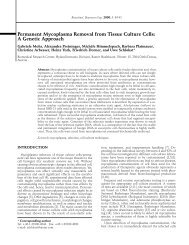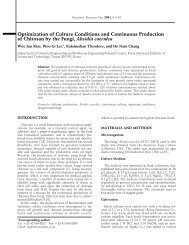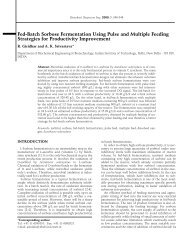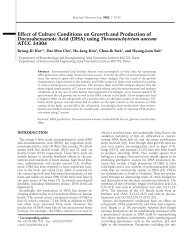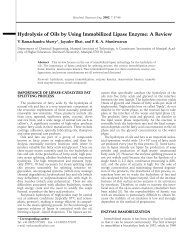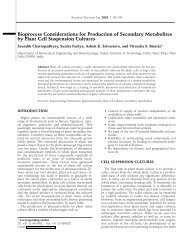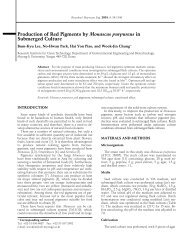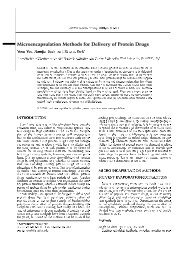Microbial Production of Riboflavin Using Riboflavin Overproducers ...
Microbial Production of Riboflavin Using Riboflavin Overproducers ...
Microbial Production of Riboflavin Using Riboflavin Overproducers ...
Create successful ePaper yourself
Turn your PDF publications into a flip-book with our unique Google optimized e-Paper software.
76 Biotechnol. Bioprocess Eng. 2001, Vol. 6, No. 2<br />
<br />
DEVELOPMENT OF MICROORGANISMS<br />
Rib<strong>of</strong>lavin is a unique vitamin that can be synthesized<br />
in large enough amounts by some fungi and bacteria<br />
to be exploited successfully on an industrial scale.<br />
Many microorganisms have been screened and studied<br />
for industrial production. Clostridium acetobutylicum was<br />
one <strong>of</strong> the earliest organisms used to produce rib<strong>of</strong>lavin,<br />
and its productivity was only 100 mg/L [5]. Some organisms<br />
<strong>of</strong> the genus Candida [6-12] were also found to<br />
produce rib<strong>of</strong>lavin, and among these, Candida flareri<br />
achieved about 600 mg/L <strong>of</strong> rib<strong>of</strong>lavin [13]. But in order<br />
to produce higher levels <strong>of</strong> rib<strong>of</strong>lavin production using<br />
these yeasts, inhibition due to iron should be overcome<br />
[6]. The biochemical key to rib<strong>of</strong>lavin overproduction<br />
appears to involve resistance to the repressive effects <strong>of</strong><br />
iron. In the biochemical synthesis <strong>of</strong> rib<strong>of</strong>lavin <strong>of</strong> normal<br />
microorganisms, it appears that iron represses almost<br />
all <strong>of</strong> the rib<strong>of</strong>lavin biosynthetic enzymes,<br />
whereas rib<strong>of</strong>lavin or a derivative inhibits the first enzyme<br />
<strong>of</strong> the pathway, GTP cyclohydrolase II. New processes<br />
to overcome iron inhibitions and novel mutation<br />
techniques [4] that inhibit purine biosynthesis using<br />
antimetabolite, tuberculin, in Candida famate have recently<br />
been developed and give rib<strong>of</strong>lavin yields <strong>of</strong> 20 to<br />
30 g/L [1,14]. On the other hand, unlike the yeast. Bacteria,<br />
iron inhibition is not a factor for the two yeastlike<br />
molds, Eremothecium ashbyii and Ashbya gossypii,<br />
which are natural overproducers <strong>of</strong> rib<strong>of</strong>lavin. The productivity<br />
<strong>of</strong> these ascomycetes presently is believed to<br />
exceed 20 g/L [1]. Both are pathogenic on cotton and<br />
form needle-shaped ascospores.<br />
Eremothecium ashbyii<br />
The overproduction <strong>of</strong> rib<strong>of</strong>lavin by this strain was<br />
discovered by Guilliermond and co-workers [15] in 1935.<br />
Hence, because it is an overproducer <strong>of</strong> rib<strong>of</strong>lavin, much<br />
work has been undertaken up on E. ashbyii over decades.<br />
In the early 1950s, media that supported rib<strong>of</strong>lavin<br />
overproduction at 200 mg/L were developed [16-18].<br />
Further addition <strong>of</strong> Tween 80 and certain proteins, casein<br />
or glycine to this allowed yields to reach 1.4 g/L<br />
[18]. Currently, yields <strong>of</strong> 1.5 to 2.5 g/L [5, 19] are possible<br />
when very crude sources are used as media.<br />
To increase productivity, 8-azaguanine, an analog <strong>of</strong><br />
guanine, which is a precursor <strong>of</strong> the rib<strong>of</strong>lavin biosynthetic<br />
pathway, was used. Mutants were obtained to<br />
get this compound. The level <strong>of</strong> vitamin production<br />
obtained from the majority <strong>of</strong> mutants in a synthetic<br />
medium containing peptone was 2-4 times higher than<br />
the level <strong>of</strong> the original strain [20].<br />
Recent studies with wild type <strong>of</strong> E. ashbyii have<br />
yielded 3.3 g/L <strong>of</strong> rib<strong>of</strong>lavin using molasses and peanut<br />
seed cake as carbon and nitrogen source, respectively<br />
[21]. Some studies with yeast-like strains have been<br />
undertaken from the viewpoint <strong>of</strong> morphological observation.<br />
The ideal colony for rib<strong>of</strong>lavin production was<br />
characterized by its medium growth intensity (colony<br />
size, 8-10 mm in diameter over a culturing period <strong>of</strong> 96<br />
h), intense yellow color, absence <strong>of</strong> sector formation,<br />
and a smooth surface covered by air mycelia [22]. <strong>Production</strong><br />
<strong>of</strong> rib<strong>of</strong>lavin using a colony obtained on the<br />
basis <strong>of</strong> these observations reached 1.1 g/L from a starting<br />
position <strong>of</strong> 0.2 g/L, and these results were confirmed<br />
by subsequent experiments [23]. The capacity for rib<strong>of</strong>lavin<br />
biosynthesis by E. ashbyii was characterized by<br />
the considerable heterogeneity <strong>of</strong> the population. This<br />
heterogeneity was expressed in a high frequency <strong>of</strong><br />
splitting <strong>of</strong>f <strong>of</strong> lemon colony, which had a vitamin<br />
production level three times lower than that <strong>of</strong> the<br />
orange colonies. A population <strong>of</strong> a culture <strong>of</strong> E. ashbyii<br />
showed high morphological instability, as well as<br />
considerable heterogeneity with respect to its ability to<br />
synthesize rib<strong>of</strong>lavin [23]. The relationship between the<br />
pH value <strong>of</strong> the medium and morphological variations<br />
was also observed. Highest rib<strong>of</strong>lavin productivity was<br />
reported at initial pH <strong>of</strong> 6.5, using E. ashbyii [24,25]. At<br />
this constant pH value, morphological variation was<br />
shown to involve the gradual increase <strong>of</strong> swollen hyphal<br />
cells and the formation <strong>of</strong> ascospores [26]. However, obtained<br />
at various pH values showed that the highest<br />
rib<strong>of</strong>lavin productivity was obtained at pH value <strong>of</strong> 4.5<br />
to 5.5 and morphological examination revealed that asci<br />
and ascospores outnumbered the other forms [26].<br />
Ashbya gossypii<br />
Another rib<strong>of</strong>lavin overproducer, A. gossypii was<br />
known to yield more rib<strong>of</strong>lavin than E. ashbyii [27].<br />
However, with similar constructs and equivalent yield,<br />
E. ashbyii showed neither nuclear fusion nor meiosis<br />
[28]. On the contrary, E. ashbyii showed instable in<br />
storage, for example during lyphophilization or storage<br />
in slant at room temperature [29].<br />
The ability <strong>of</strong> A. gossypii to overproduce rib<strong>of</strong>lavin<br />
was discovered in 1946 [30]. The characteristics and<br />
fermentation <strong>of</strong> this strain are very similar to those <strong>of</strong> E.<br />
ashbyii. After the discovery <strong>of</strong> this yeast-like, filamentous<br />
fungus, the industrial producer <strong>of</strong> rib<strong>of</strong>lavin has<br />
moved to A. gossypii, which has replaced E. ashbyii [31].<br />
The first application <strong>of</strong> A. gossypii to industrial scale<br />
production was made in 1968 [2]. Since the first quantitive<br />
report [30] numerous studies have been carried out<br />
to overproduce rib<strong>of</strong>lavin. In early studies, some defined<br />
media were established using Tween 80 and purine, and<br />
145 mg/L and later 370 mg/L <strong>of</strong> rib<strong>of</strong>lavin were produced<br />
in use <strong>of</strong> these media [32,33]. Many media were<br />
then developed [34] which contained glucose, vitamins,<br />
and amino acids, and mineral salts. In these markedly<br />
improved media, the production <strong>of</strong> rib<strong>of</strong>lavin reached 1<br />
g/L. It was found that glycine was an important component<br />
and Tween 80 served to prevent mycelium lysis<br />
and stimulator for rib<strong>of</strong>lavin overproduction. Apart<br />
from these media, more complex media for industrial<br />
application were studied, and using soybean oil as a<br />
carbon source and collagenous protein and CSL as nitrogen<br />
sources, yields <strong>of</strong> 5 g/L were obtained [35,36].<br />
The same amount <strong>of</strong> rib<strong>of</strong>lavin was produced using<br />
other newly developed media, which included 3% bone





